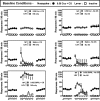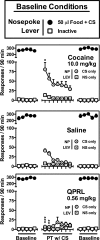Influence of conditioned reinforcement on the response-maintaining effects of quinpirole in rats
- PMID: 19696656
- PMCID: PMC3269766
- DOI: 10.1097/FBP.0b013e328330ad9b
Influence of conditioned reinforcement on the response-maintaining effects of quinpirole in rats
Abstract
D2-like agonists, such as quinpirole, maintain responding in monkeys, rats, and mice when they are substituted for cocaine. This study examined the influence of operant history and cocaine-paired stimuli (CS) on quinpirole-maintained responding in rats trained to nose poke for cocaine. Upon acquisition of responding for cocaine, substitutions were performed in the presence or absence of injection-CS pairings. Although cocaine maintained responding regardless of whether injections were accompanied by CS, quinpirole maintained responding only when CS were paired with injections. To assess the influence of operant history, injections of cocaine, quinpirole, remifentanil, nicotine, or saline were made available on a previously inactive lever, while nose pokes continued to result in CS presentation. Although responding was reallocated from the nose poke to the lever when cocaine or remifentanil was available, lever presses remained low, and nose poking persisted when quinpirole or nicotine was made contingent upon lever presses. Finally, quinpirole pretreatments resulted in high rates of nose poking when nose pokes resulted in CS presentation alone, but failed to maintain nose poking when the CS was omitted. Taken together, these results suggest that the response-maintaining effects of quinpirole are primarily mediated by an enhancement of the conditioned reinforcing effects of earlier CS, rather than by a reinforcing effect of quinpirole.
Figures





Similar articles
-
Drug and reinforcement history as determinants of the response-maintaining effects of quinpirole in the rat.J Pharmacol Exp Ther. 2007 Nov;323(2):599-605. doi: 10.1124/jpet.107.123042. Epub 2007 Aug 3. J Pharmacol Exp Ther. 2007. PMID: 17675585
-
Dopamine D2/D3 receptors modulate cocaine's reinforcing and discriminative stimulus effects in rhesus monkeys.Drug Alcohol Depend. 1999 Apr 1;54(2):97-110. doi: 10.1016/s0376-8716(98)00162-8. Drug Alcohol Depend. 1999. PMID: 10217549
-
Feeding condition and the relative contribution of different dopamine receptor subtypes to the discriminative stimulus effects of cocaine in rats.Psychopharmacology (Berl). 2014 Feb;231(3):581-91. doi: 10.1007/s00213-013-3271-x. Epub 2013 Sep 13. Psychopharmacology (Berl). 2014. PMID: 24030470 Free PMC article.
-
Acquisition of responding with a remifentanil-associated conditioned reinforcer in the rat.Psychopharmacology (Berl). 2013 Sep;229(2):235-43. doi: 10.1007/s00213-013-3102-0. Epub 2013 Apr 23. Psychopharmacology (Berl). 2013. PMID: 23609770 Free PMC article.
-
Locomotor activity and cocaine-seeking behavior during acquisition and reinstatement of operant self-administration behavior in rats.Behav Brain Res. 2005 May 28;160(2):250-9. doi: 10.1016/j.bbr.2004.12.005. Epub 2005 Jan 12. Behav Brain Res. 2005. PMID: 15863221
Cited by
-
Effects of pramipexole on the reinforcing effectiveness of stimuli that were previously paired with cocaine reinforcement in rats.Psychopharmacology (Berl). 2012 Jan;219(1):123-35. doi: 10.1007/s00213-011-2382-5. Epub 2011 Jun 24. Psychopharmacology (Berl). 2012. PMID: 21701814 Free PMC article.
-
You are what you eat: influence of type and amount of food consumed on central dopamine systems and the behavioral effects of direct- and indirect-acting dopamine receptor agonists.Neuropharmacology. 2012 Jul;63(1):76-86. doi: 10.1016/j.neuropharm.2012.02.005. Epub 2012 Feb 23. Neuropharmacology. 2012. PMID: 22710441 Free PMC article. Review.
-
Dopamine D3 and 5-HT1B receptor dysregulation as a result of psychostimulant intake and forced abstinence: Implications for medications development.Neuropharmacology. 2014 Jan;76 Pt B(0 0):301-19. doi: 10.1016/j.neuropharm.2013.08.014. Epub 2013 Aug 23. Neuropharmacology. 2014. PMID: 23973315 Free PMC article. Review.
-
Self-administration of agonists selective for dopamine D2, D3, and D4 receptors by rhesus monkeys.Behav Pharmacol. 2012 Aug;23(4):331-8. doi: 10.1097/FBP.0b013e3283564dbb. Behav Pharmacol. 2012. PMID: 22785383 Free PMC article.
-
The role of dopamine in risk taking: a specific look at Parkinson's disease and gambling.Front Behav Neurosci. 2014 May 30;8:196. doi: 10.3389/fnbeh.2014.00196. eCollection 2014. Front Behav Neurosci. 2014. PMID: 24910600 Free PMC article. Review.
References
-
- Amato D, Milella MS, Badiani A, Nencini P. Compulsive-like effects of repeated administration of quinpirole on drinking behavior in rats. Behav Brain Res. 2006;172:1–13. - PubMed
-
- Caggiula AR, Donny EC, White AR, Chaudhri N, Booth S, Gharib MA, Hoffman A, Perkins KA, Sved AF. Environmental stimuli promote the acquisition of nicotine self-administration in rats. Psychopharmacology (Berl) 2002;163:230–237. - PubMed
-
- Caine SB, Koob GF. Modulation of cocaine self-administration in the rat through D-3 dopamine receptors. Science. 1993;260:1814–1816. - PubMed
Publication types
MeSH terms
Substances
Grants and funding
LinkOut - more resources
Full Text Sources

